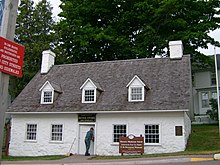
Back American Fur Company German American Fur Company Spanish American Fur Company Finnish American Fur Company French American Fur Company NB American Fur Company Polish American Fur Company Portuguese Американская меховая компания Russian American Fur Company Swedish
 | |
| Company type | Private |
|---|---|
| Industry | Fur trade |
| Founded | New York City, United States (1808) |
| Founder | John Jacob Astor |
| Defunct | 1847 |
| Fate | Dissolved |
| Headquarters | New York City |
Area served | United States and Territories |
The American Fur Company (AFC) was a prominent American company that sold furs, skins, and buffalo robes.[1][2] It was founded in 1808, by John Jacob Astor, a German immigrant to the United States.[3] During its heyday in the early 19th century, the company dominated the American fur trade. The company went bankrupt in 1842 and was dissolved in 1847.
During the 18th century, furs had become a major commodity in Europe, and Indigenous people in North America became a major supplier. Several British companies, most notably the North West Company (NWC) and the Hudson's Bay Company, competed against Astor and capitalized on the lucrative trade in furs. Astor used a variety of commercial strategies to become one of the first trusts in American business and a major competitor to the British commercial dominance in North American fur trade.[1] Expanding into many former British fur-trapping regions and trade routes, the company grew to monopolize the fur trade in the United States by 1830, and became one of the largest and wealthiest businesses in the country.
Astor planned for several companies to function across the Great Lakes, the Great Plains and the Oregon Country to gain control of the North American fur trade. Comparatively inexpensive manufactured goods were to be shipped to commercial stations for trade with various Indigenous nations for fur pelts. The sizable number of furs collected were then to be brought to the port of Canton, as pelts were in high demand in the Qing Empire. Chinese products were, in turn, to be purchased for resale throughout Europe and the United States. A beneficial agreement with the Russian-American Company was also planned through the regular supply of provisions for posts in Russian America. This was planned in part to prevent the rival Montreal based NWC to gain a presence along the Pacific Coast, a prospect neither the Russian colonial authorities or Astor favored.[4]
Demand for furs in Europe began to decline during the early 19th century, leading to the stagnation of the fur trade by the mid-19th century. Astor left his company in 1830, the company declared bankruptcy in 1842, and the American Fur Company ultimately ceased trading in 1847.
- ^ a b Nute, Grace Lee (1926). "The American Fur Company's Fishing Enterprises on Lake Superior". The Mississippi Valley Historical Review. 12 (4): 483–503. doi:10.2307/1891245. ISSN 0161-391X.
- ^ Nute, Grace Lee (1927). "The Papers of the American Fur Company: A Brief Estimate of their Significance". The American Historical Review. 32 (3): 519–538. doi:10.2307/1837745. ISSN 0002-8762.
- ^ Ingham 1983, pp. 26–27.
- ^ Tikhmenev 1978, pp. 116–118.